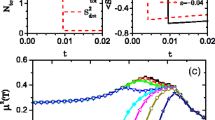Abstract
This chapter is concerned with charge carrier propagation and the associated energy spectrum in asymmetric quantum double-dot systems embedded in a two dimensional host sheet subject to Landau quantization. The two dots are modeled by two Dirac delta function potential terms of differing depths (each of which would support just one subband state if the other were absent, if there were no magnetic field). The Dyson-like integral equation for the Green’s function of such a double-dot system is solved exactly in closed form in terms of the infinite sheet Green’s function for two dimensional charge carriers subject to Landau quantization in the absence of the quantum dots. The dispersion relation for the coupled double-quantum-dot subband energies is formulated and examined by analyzing the frequency poles of the Green’s function, with Landau-quantization-like splintering of both of the dot levels by the magnetic field, modified by the proximity of the two dots. The effects of the asymmetry of the quantum dots in regard to their differing potential well depths are analyzed as functions of the well depth difference and dot separation. These studies are carried out here for two 2D systems: (A) nonrelativistic Landau quantized charge carriers, and (B) T-3 “Diced” lattice Dirac-like pseudospin 1 Landau quantized charge carriers.
Access this chapter
Tax calculation will be finalised at checkout
Purchases are for personal use only
Similar content being viewed by others
References
P. Harrison (ed.), Quantum Wells, Wires and Dots, 2 edn. (Wiley-Interscience, 2005)
N.J.M. Horing, Quantum Statistical Field Theory (Oxford University Press, 2017), p. 121. Also, N.J.M. Horing, M. Yildiz, Ann. Phys. (NY) 97, 216, Section 2 (1976)
A. Erdelyi, et al., Bateman Manuscript Project; Higher Transcendental Functions, vol. 2 (McGraw Hill, 1953), p. 189, #10.12.17 and p. 199
D. Widder, Advanced Calculus (Prentice-Hall Inc., 1947), p. 240
N.J.M. Horing, J. Phys. Cond. Matter 33, 015302 (2021)
Author information
Authors and Affiliations
Corresponding author
Editor information
Editors and Affiliations
14.7 Appendix
14.7 Appendix
Tables 14.5 and 14.6 exhibit the percentage difference between the first five calculated “upper” and “lower” energies and the corresponding results using the single pole approximation.
Generally, the results differ by a few percent, in a few cases about ten percent. Overall, the single pole approximation provides a reasonable estimate of the order of magnitude, with minimal numerical work.
Rights and permissions
Copyright information
© 2022 The Author(s), under exclusive license to Springer Nature Switzerland AG
About this chapter
Cite this chapter
Horing, N.J.M., Mancini, J.D., Horton, S.L. (2022). Landau Quantized Dynamics and Energy Spectra of Asymmetric Double-Quantum-Dot Systems: (a) Nonrelativistic Electrons; (b) Dirac T-3 “Diced” Lattice Carriers. In: Ünlü, H., Horing, N.J.M. (eds) Progress in Nanoscale and Low-Dimensional Materials and Devices. Topics in Applied Physics, vol 144. Springer, Cham. https://doi.org/10.1007/978-3-030-93460-6_14
Download citation
DOI: https://doi.org/10.1007/978-3-030-93460-6_14
Published:
Publisher Name: Springer, Cham
Print ISBN: 978-3-030-93459-0
Online ISBN: 978-3-030-93460-6
eBook Packages: Physics and AstronomyPhysics and Astronomy (R0)




